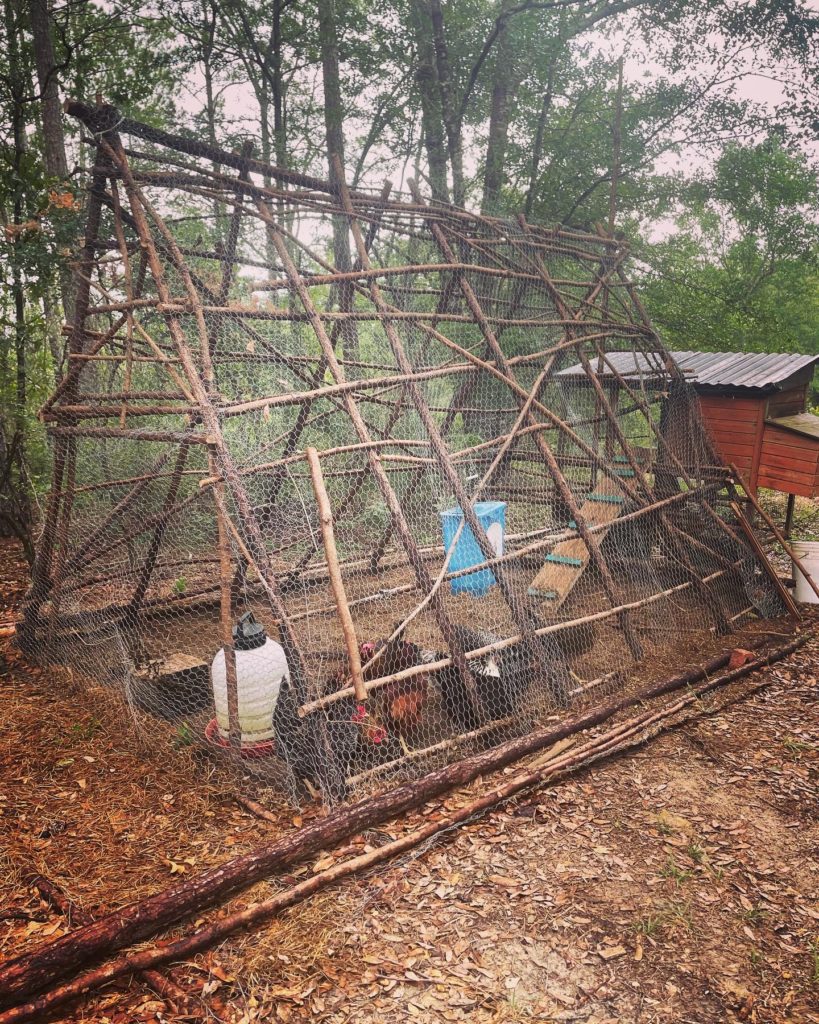The first European to see the Southeast, conquistador Hernando DeSoto described it as “a garden-like land of fruit bearing trees among which a horse could be ridden without any trouble.” Today in undeveloped areas we find unbroken thickets of trees, shrubs, and vines, not exactly filled with food. What happened?
The indigenous people of the Southeast, on our land the Choctaw (Chahta), intentionally used fire to encourage an herbaceous ground cover, which brought herds of bison to feed on this diverse understory salad mix. As the bison grazed they also trampled seeds into the ground and deposited fertilizer, coaxing the deep rooted grasses to shoot up again once they moved on. As woody plants crept back in, fire was rekindled to set the clock back to understory plants, while also releasing other nutrients in the ashes. So the cyclical succession of fertility, plants, and animals went on, feeding the people and ecosystem in a kind of light-handed animal husbandry/game management practice that the Europeans failed to even see.

Fire remains the most important tool we use to restore this land. The early settlers learned the use of fire from the natives, but they often applied it indiscriminately and with too much frequency. At AYNI, we are continually learning more about how the time of year and frequency of burning can help us to thin out unwanted brush and spur the growth of native herbs and bunching grasses. Some plants will not sprout without it. We look forward to the day we can introduce grazing animals as an ecological substitute to the great bison that settlers regretfully extirpated.
Nowadays most burns are done in chunks no smaller than 40 acres at a time, aggressively lit, and contained within firebreaks plowed in wide strips that scar and erode the land. We prefer to create small lanes by hand and carefully spread the fire along them. And by lighting smaller areas at different times, we allow for a patchwork of habitats in various stages of succession from fire, increasing overall ecological diversity.
Another contributor to the monotonous wall of green facing our region in undeveloped areas is invasive species. Here on our land imported chinese privet shrubs and cogon grass have few predators. Unchecked by natural forces, they choke out native vegetation. Having done our fair share of managing such species by hand in the past, we now choose a very selective use of less toxic herbicides as part of our strategy on these 111 acres. We’ve determined it to be the lesser of evils.
We’re fortunate to have very few of what is perhaps the most invasive tree of our region, the chinese tallow. We take a special pleasure in cutting them down, partly because they are a good substrate for growing edible mushrooms. Anyone who has been to one of our “Grow Mushrooms on Logs” workshops has probably taken home a tallow log, fully inoculated with a gourmet fungus.
When it comes to sustainably sourced food, nothing beats eating the invasive species. Next on our menu is the wild hogs. Introduced by none other than DeSoto himself (how could they have named the national forest that surrounds us after him?), they too have wrought a legacy of havoc that reverberates into the present day. Our rudimentary trap has proven unsuccessful, but they won’t evade us for long as we former city folk learn the art of hunting.
Just lighting everything on fire and removing what doesn’t belong won’t get us closer to the former Eden-like landscape described by early colonizers. For our nursery we’ve been collecting local seed and cuttings of native food bearing plants for what will become a flourishing forest of food. In the meantime we enjoy foraging the wild bounty that does exist, while also cultivating our raised beds.

But we didn’t bring in lumber for the beds. They are woven together like giant baskets using a technique called wattling, used by indigenous people the world over, everywhere resources permit. Our chicken run is in the same fashion, with a modern touch of chicken wire. Ecological restoration surprisingly often calls not just for fire, but cutting many trees down. By thinning out these close-growing, long skinny trees, we are allowing more light to hit the forest floor, again encouraging a diverse ground cover.
This again means critical habitat for our best friends, the gopher tortoises. One part of good habitat is safety from predators, which is why we are removing hogs and requiring dogs to be leashed. With the help of local biologists we are monitoring their populations as we work to bring them back from their endangered status. We are continually inspired by these unique reptiles, who are known for sharing their burrows with a huge diversity of creatures. From mice to snakes to frogs and even owls, when the fires blaze on the savannah, all types find safety in the tortoise burrows. As our mascot, the tortoises remind us of the miracles of community, diversity, and interdependence that are made possible when disaster strikes.
Sometimes the world today can feel like it’s on fire. In the Gulf Coast Region, the constant threat of hurricanes, environmental degradation and pollution, rising seas and sinking soils, can make it challenging to feel optimistic about our future. We aim to meet that challenge through deep listening and reverence for all the land has to show us about what it means to honor life. We model ourselves after the lichen and the tortoises, surviving through mutuality and interdependence when times get tough. At All You Need, we know that when we depend on each other, all things become possible, and sometimes, when all is rendered into ash, it is laying the seedbed for something even more fertile to take root.

